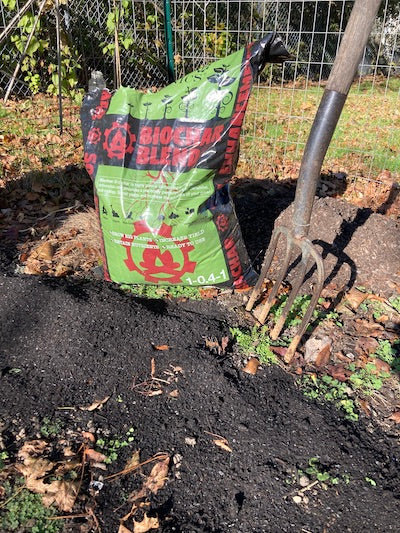Getting a Leg Up for Next Spring
Share
Except for a few hardy greens left to harvest , we’re done with the gardens for this season. And by “done” I mean we’ve got very little energy left to give to our outdoor gardening habit this year. It’s time to wrap up the growing season for good. That energy we do have left will be spent on getting a leg up in the garden for next spring. While it’s easy to just cuddle up with the cat or dog for winter, the tasks we complete now will help us get a great start early next spring. In fact, one of the tasks you do now—applying Biochar Blend—will have long-lasting benefits to your garden beds—maybe even for the garden’s entire lifetime. We’ll save that one for last.

In The Veggie Garden, Remove It All
“Cleanliness is next to godliness,” as the saying goes. Put another way, plants, weeds, dead materials—and even trash—provide homes where pests and diseases can hang out in comfort over the winter, unleashing a devil of disease and pest issues next spring. Do your best to remove all debris from your vegetable gardens to remove nesting spots and possible fungal and viral contaminants.
In your flower beds, leaving spent foliage and seed heads up till spring provides overwintering cover for beneficial insects, and provides food for hungry birds over winter. I love watching the Goldfinches eat my Coneflower seeds in the middle of winter! Veggie pests and diseases won’t hang out in flower beds, as their host plants are your yummy veggies, so keep the clean up to your veggie garden and do Mother Nature a favor.
Fertilize That Garlic
Of course if you have planted garlic in your garden, you are not removing that crop. Planted early enough in fall, it may in fact have emerged from the ground upwards of 4 inches. Give it a bit of a jump on spring by adding a 2-in. layer of compost (either your own, or our Planting Mix Compost Blend) after you clean up dead leaves and such around your garlic rows. Compost is the No. 1 best amendment for your garlic crop, so don’t be shy about it.
Shut Down Your Compost Pile
This is more of a “garden-adjacent” putting-your-garden-to-bed recommendation. The compost pile you’ve been adding table scraps and garden clippings to all season needs to be given time to cook, as I like to call it; i.e. add no more material to it, turn it occasionally, and let it form an incorporated compost structure so it’s ready to use come springtime. Feel free to start another compost pile to which you’ll add the constant stream of compostable food waste coming out of your kitchen.
Apply Biochar
The true secret to getting a jump on next spring—and possibly a lot of future springs—is to apply biochar to your garden. This material is 100% pure carbon burned in the absence of oxygen. Biochar holds moisture and nutrients in the soil and creates “homes” for beneficial soil biology. Biochar also helps roots form densely, which leads to plants taking up more nutrients. And, as a bonus, research shows that plants in biochar-supported soils resist stressors better and produce higher-quality fruits, flowers and even cannabis. Miracle of modern technology? Actually, biochar was being used for agricultural purposes in the Amazon more than 1,000 years ago. Those same soils are still productive and teeming with biological life today. That’s a strong indicator that the biochar you add to your gardens this fall will be working for years to come. Yes!

Our Organic Mechanics Biochar Blend is a “’pre-charged” product that comes ready-to-use with the addition of compost, worm castings, kelp meal, alfalfa meal and bone char, which provides phosphorus and calcium. It also contains azomite (a volcanic ash deposit) and zeolite, both of which nourish the soil microbe ecosystem around plant roots. All those ingredients charge up the biochar and allow it to make an impact in the soil right away.
Spread a ½-in. layer of Biochar Blend over the soil and dig into the ground to the depth of one shovel. Adding it in the fall allows the biochar to help create an interconnected community of beneficial soil organisms. Our 1 cu.ft. bag covers 24 sq.ft. at a 10% rate. Once your plants get in the ground in spring, those beneficials will make an immediate impact on plant growth. And then it’s off to the races! Our founder Mark Highland created a super-informative video all about biochar. Check it out HERE—he makes the concept so easy to understand!
Biochar and Your Garlic Crop
Getting back to your garlic crop for a second. You may not be able to turn the earth with biochar under your emerging garlic plants, but you can add biochar around the outside of your rows. Churn it in, then apply that 2-in. compost layer. You’ll have some righteously big plants and a bountiful garlic harvest next summer. As will happen with your entire veg crop! Adding a proven product that’ll enhance your garden next spring—what a way to end your gardening season, huh?
Speaking of garlic, our very own Mark Highland created a video all about planting the crop. It’s not too late to get them in the ground! Watch the VIDEO to learn how it’s done (psst: It’s easy!).
One last bit about biochar—recent studies found that biochar helps remediate lead in soils. Researchers found that a biochar amendment reduces the availability of lead in the soil. It also reduced lead’s uptake in lettuce. Biochar—we’ve always known it was a Super Hero! Can’t wait to see its other super powers revealed.
Order your Biochar Blend and find out more information about the product on THIS PAGE.





